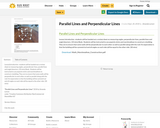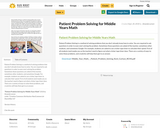
PowerPoint Presentation (with Notes) to build collective responsibility and implement outcome based math 1-9.
- Subject:
- Math
- Material Type:
- Unit of Study
- Date Added:
- 11/26/2018

PowerPoint Presentation (with Notes) to build collective responsibility and implement outcome based math 1-9.

Two besotted rulers must embrace proportional units in order to unite their lands. It takes mathematical reasoning to identify the problem, and solution, when engineers from Queentopia and Kingopolis build a bridge to meet in the middle of the river.

This site offers math videos for students in the following areas:
Counting and Cardinality
Operations & Algebraic Thinking
Number & Operations in Base Ten
Geometry
Measurement & Data
Number & Operations—Fractions
Ratios & Proportional Systems
Statistics & Probability
The Number System
Expressions & Equations
Functions

Today we're going to talk about p-hacking (also called data dredging or data fishing). P-hacking is when data is analyzed to find patterns that produce statistically significant results, even if there really isn't an underlying effect, and it has become a huge problem in science since many scientific theories rely on p-values as proof of their existence! Today, we're going to talk about a few ways researchers have "hacked" their data, and give you some tips for identifying and avoiding these types of problems when you encounter stats in your own lives.

Last week we introduced p-values as a way to set a predetermined cutoff when testing if something seems unusual enough to reject our null hypothesis - that they are the same. But today we’re going to discuss some problems with the logic of p-values, how they are commonly misinterpreted, how p-values don’t give us exactly what we want to know, and how that cutoff is arbitrary - and arguably not stringent enough in some scenarios.

LessonIntroduction
-students will be handed out a review sheet on measuring angles, perpendicular lines, parallel lines and angle bisectors. (10 mins)
Body
-Students will be instructed to use popsicle sticks and marshmallows to construct a building. They are to ensure that some walls will be perpendicular to each other as well as parallel along with the roof. An expectation is that the building will be symmetrical and all angles on each side will be equal to the other side. (30 mins)

An interactive applet and associated web page that demonstrate the concept of parallel lines. The applet shows two lines, one of which has draggable endpoints. As the line is changed by dragging them, the other line changes to remain parallel to it. Applet can be enlarged to full screen size for use with a classroom projector. This resource is a component of the Math Open Reference Interactive Geometry textbook project at http://www.mathopenref.com.

An interactive applet and associated web page that demonstrate the properties of parallel lines in coordinate geometry. The applet presents two lines, each defined by a pair of draggable points. If they are parallel the slopes are the same and the applet adds the parallel arrow marks to them. The slope of each line is continuously recalculated and the case of vertical lines (with undefined slope) is handled correctly. The is a software 'detent' that snaps the lines to parallel if they are close to it. The grid, axis pointers and coordinates can be turned on and off. The slope calculation can be turned off to permit class exercises and then turned back on the verify the answers. The applet can be printed as it appears on the screen to make handouts. The web page has a full description of the method for determining if lines are parallel, a worked example and has links to other pages relating to coordinate geometry. Applet can be enlarged to full screen size for use with a classroom projector. This resource is a component of the Math Open Reference Interactive Geometry textbook project at http://www.mathopenref.com.

A web page and interactive applet showing the definition and properties of a parallelogram. The applet shows a parallelogram where the user can drag any vertex. The other points then move in such a way that the figure remains a parallelogram at all times. A control to hide the details allows a classroom discussion where students can try to infer what the properties are as it is reshaped by the discussion leader. Text on the page has the formal definition and properties of the parallelogram with links to related pages. A companion page is http://www.mathopenref.com/parallelogramarea.html showing the ways to calculate the area of a parallelogram Applet can be enlarged to full screen size for use with a classroom projector. This resource is a component of the Math Open Reference Interactive Geometry textbook project at http://www.mathopenref.com.

A handout for parent use. Tips, strategies and resources to help students increase math fluency with help from parents at home.

Patient Problem Solving is a method of solving problems that you don't
already know how to solve. You are required to ask questions in order to
even start solving the problem. Sometimes those questions are asked of the
teacher, sometimes other students, and sometimes Google. For example,
students are asked to use a ticker tape timer to calculate their speed. First of
all students (and maybe you as the teacher) need to figure out what a ticker
tape timer does. There are a variety of ways to solve these problems, and
creativity will help them get to an answer.

Navigate the number line while diving amidst shipwrecks and sunken ruins. Will you find a pearl, or an old boot? Watch out for the electric eel! Pearl Diver teaches properties of numbers, how to plot numbers, how to visualize quantity on the number line, how to order numbers, and how to use the number line as a visual model for mathematical operations.

A web page and interactive applet illustrating the properties of a pentagon (5 sided polygon). The applet shows a pentagon where the user can drag any vertex to reshape it. User can see that the interior and exterior angles are constant in a regular pentagon, but vary in an irregular version. Controls allow the display or hiding of the diagonals, and triangles within the pentagon. The web page lists the properties of a pentagon including interior angles, exterior angles, sum of exterior angles, area, number of diagonals and number of internal triangles. Links to pages with generalized properties of all polygons. Applet can be enlarged to full screen size for use with a classroom projector. This resource is a component of the Math Open Reference Interactive Geometry textbook project at http://www.mathopenref.com.

A web page and interactive applet show how to compute the perimeter of a kite. A kite is shown that can be resized by dragging its vertices. As you drag, the perimeter is continuously recalculated. Text on the page explains that the perimeter is the sum of the sides. For those who prefer it, in a formula that is given. Applet can be enlarged to full screen size for use with a classroom projector. This resource is a component of the Math Open Reference interactive geometry reference book project at http://www.mathopenref.com.

A web page and interactive applet show how to compute the perimeter of a parallelogram. A parallelogram is shown that can be resized by dragging its vertices. As you drag, the perimeter is continuously recalculated. Text on the page explains that the perimeter is the sum of the sides. For those who prefer it, in a formula that is given. Applet can be enlarged to full screen size for use with a classroom projector. This resource is a component of the Math Open Reference interactive geometry reference book project at http://www.mathopenref.com.

A web page and interactive applet show how to compute the perimeter of a polygon. A polygon is shown that can be resized by dragging its vertices. As you drag, the perimeter is continuously recalculated. Text on the page explains that the perimeter is the sum of the sides. For those who prefer it, in a formula that is given. Applet can be enlarged to full screen size for use with a classroom projector. This resource is a component of the Math Open Reference interactive geometry reference book project at http://www.mathopenref.com.

A web page and interactive applet show how to compute the perimeter of a rectangle. A rectangle is shown that can be resized by dragging its vertices. As you drag, the perimeter is continuously recalculated. Text on the page explains that the perimeter is the sum of the sides. For those who prefer it, in a formula that is given. Applet can be enlarged to full screen size for use with a classroom projector. This resource is a component of the Math Open Reference interactive geometry reference book project at http://www.mathopenref.com.

A web page and interactive applet show how to compute the perimeter of a rhombus. A rhombus is shown that can be resized by dragging its vertices. As you drag, the perimeter is continuously recalculated. Text on the page explains that the perimeter is the sum of the sides. For those who prefer it, in a formula that is given. Applet can be enlarged to full screen size for use with a classroom projector. This resource is a component of the Math Open Reference interactive geometry reference book project at http://www.mathopenref.com.

A web page and interactive applet show how to compute the perimeter of a square. A square is shown that can be resized by dragging its vertices. As you drag, the perimeter is continuously recalculated. Text on the page explains that the perimeter is the sum of the sides. For those who prefer it, in a formula that is given. Applet can be enlarged to full screen size for use with a classroom projector. This resource is a component of the Math Open Reference interactive geometry reference book project at http://www.mathopenref.com.

A web page and interactive applet show how to compute the perimeter of a trapezoid. A trapezoid is shown that can be resized by dragging its vertices. As you drag, the perimeter is continuously recalculated. Text on the page explains that the perimeter is the sum of the sides. For those who prefer it, in a formula that is given. Applet can be enlarged to full screen size for use with a classroom projector. This resource is a component of the Math Open Reference interactive geometry reference book project at http://www.mathopenref.com.